Every flight begins and ends on the ground. And when we’re not flying, the airplane has to be stored somewhere. In fact, the typical personal aircraft spends far more time on the ground than above it. Rarely do we have a genuine drive-in, drive-out parking or storage situation, so the airplane gets pushed, pulled and towed into its tiedown or hangar when it’s not in use.
All this pushing and pulling can exact a toll on an airplane, typically by running it into things. Meanwhile, when we’re not pushing and pulling the airplane, it’s subject to a variety of effects, including wind, rain, snow and ice, and prop blasts from other aircraft. It’s ironic that airplanes often suffer more damage on the ground than while in flight, but there are ways pilots and owners can minimize the carnage.
Parking and Storage
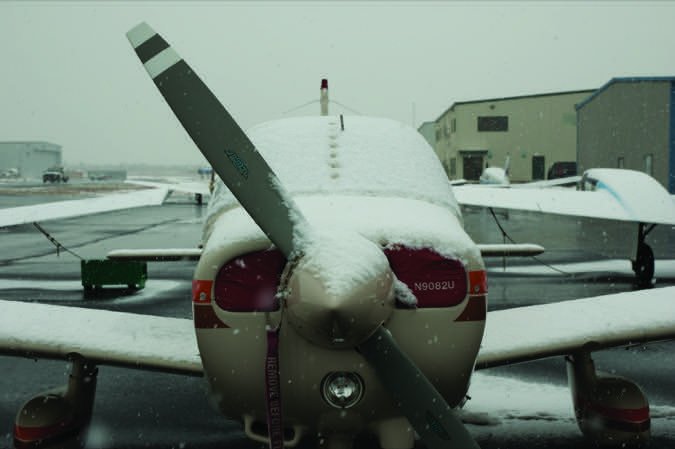
Not only is where you park your aircraft important, but who your neighbors are can have a significant impact on its durability. Fellow pilots who use a lot of throttle taxiing out of a nearby parking position can damage your aircraft, especially if it’s not properly tied down with secured flight controls. Parking near a run-up area means possible damage from stones and debris blown up by aircraft just doing a normal run-up no matter which way your plane is facing. And don’t even think about parking near helicopter operations.
Some pilots may not even chock the wheels but instead use the parking brake. Aircraft parking brakes were never intended for anything but temporary short-term parking. Over time, parking brake valves can leak internally and release pressure. Another problem is that when brake discs get hot after landing or extended taxi, they can warp when the parking brake is set. Placing chocks on both main wheels makes much more sense and takes little time. And FBOs often need to relocate airplanes on their ramps, which is problematic when the parking brake is set. Meanwhile, winter operations on snow- or ice-covered ramps mean it may not be possible to adequately secure your aircraft unless it’s tied down: Chocks can easily slip and even setting a well-functioning parking brake may not prevent aircraft movement.
Tie downs are another important item. Ropes are especially susceptible to weather damage and rot, and chain or wire rope also can become compromised over years of severe weather. Check the anchor points, as well as ropes or chains for damage and replace anything that looks questionable. Most airport authorities do not supply or maintain tiedown ropes and chains due to liability issues, so check with your airport manager as to what their policy is.
Hangar Rash

Storing the airplane in a hangar eliminates concerns about tiedown ropes and chains but raises other issues, including hangar rash, the often slight damage that can occur when aircraft are moved around in a tight space. In fact, a simple scrape up against a hangar wall may not look bad externally, but internal structural damage may have occurred. Never take any scrape or dent as being insignificant; always have a mechanic check it out before flying the aircraft.
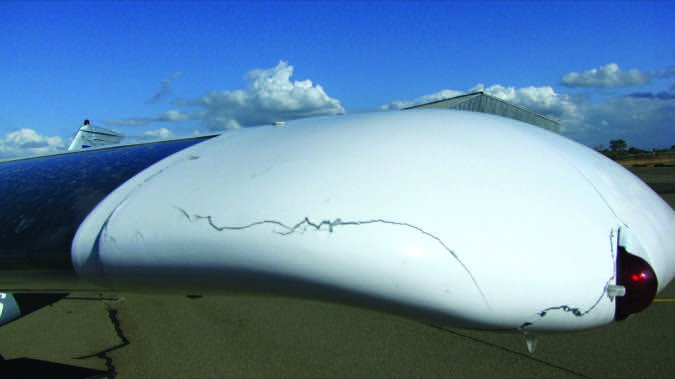
When moving aircraft into or out of a hangar, it’s always best to have one or more helpers watching to help prevent contact with anything. When using any motorized equipment to push or tow an aircraft, be very careful not to exceed steering angle limits on the nose gear. Nose gear struts, mounting structure and steering mechanisms can be easily damaged during towing or pushing operations. A thorough preflight of these areas, including operational checks during taxi, should determine there is no binding or restriction of the nose wheel.
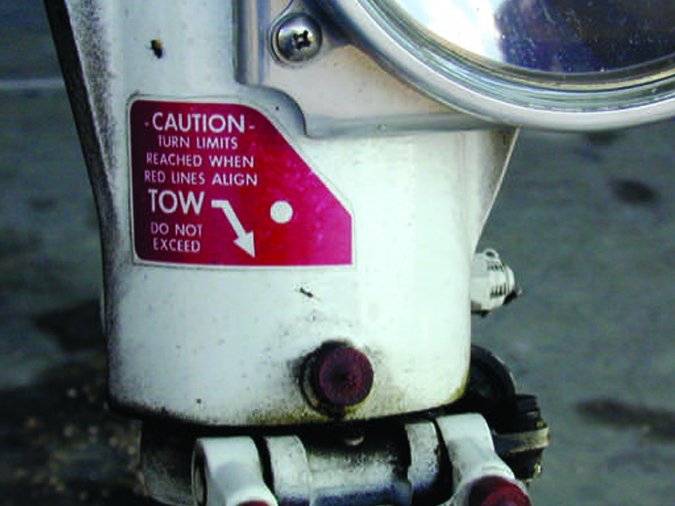
If you are not experienced in towing or pushing an aircraft, practice moving it in a flat open area before attempting to operate in close quarters. Make certain that the person you use as a spotter knows what to do in case the tow equipment becomes disconnected from the aircraft. Also, be certain that you as a tow operator can clearly communicate with your spotter or guide by prearranged hand signals or voice commands. Always open hangar doors completely—even if your aircraft can easily clear the doors—that extra few feet of opening can make a difference should an error occur.
Snow and Ice
Preventing damage from snow and ice on a plane is somewhat of an art that many old-timers have learned over the years. Cleaning and waxing your plane thoroughly before winter is a good place to start to prevent snow and ice damage.
Covers for the wings and tail can also help if installed properly. Several companies make these covers for specific aircraft, and you can make your own or have them produced locally. Regardless of where they’re sourced, damage to paint, windows, plastic parts and antennas can result when loose-fitting covers shift or flap in the wind. Each fabric cover should have enough straps to keep it securely attached. Dirty covers also contribute to aircraft damage by mixing grit and dust between the cover and the aircraft surface, scratching external surfaces during windy conditions. Cleaning your covers will go a long way to preventing aircraft damage. If you use wing covers for an airplane parked outside, consider installing something to destroy any lift created during high wind conditions. A spoiler—maybe made from a length of 2×4 lumber—secured to the top of the wing and tail surfaces can be effective at preventing movement of the covers while ensuring strong winds don’t shift the airplane’s position.
Snow buildup on an aircraft is also a problem in that excessive amounts of snow can pose a problem with just the weight of the snow on the aircraft surface. Clean off snow from your aircraft periodically with a soft brush to prevent damage.
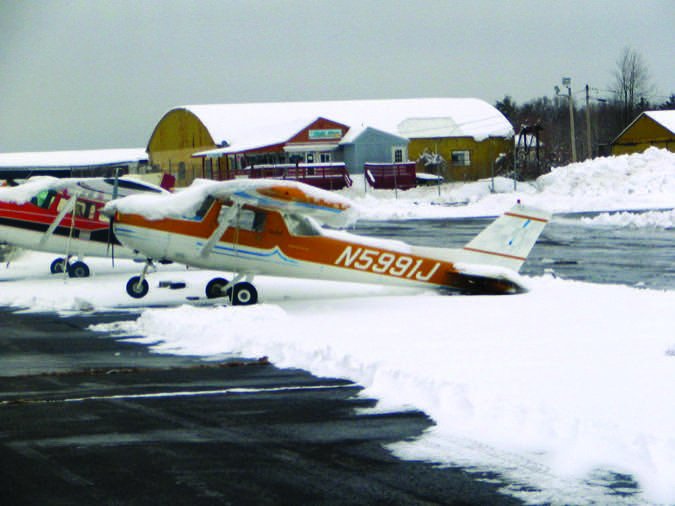
Another problem to consider regarding ice is that frozen water may damage an aircraft or add weight where you don’t want it. Water drain holes—typically under the aft fuselage, in the tail section and on the underside of flight controls—must be clear. Debris from bird nests, rodent activity and dirt can block drain holes. Even if you are not based in areas where this moisture can freeze, any additional weight added to a control surface, especially its low point, can disturb the surface’s balance, possibly leading to aerodynamic flutter the next time you fly. At the same time, make certain to check flight controls for freedom of movement: It’s possible for flight control cables to become fouled by ice in extreme cases. In any event, move the control surfaces through their complete travel and allow liquid water to drain.
Control locks and creative ways to tie the controls down can in fact contribute to damage by positioning a control surface in such a way to allow moisture to enter the airframe or flight controls. Tying the flight controls with the seat belt can prevent them from banging around in windy conditions but may also increase the likelihood of water entering the airplane’s structure and then freezing.

While few aircraft these days seem to have their original control lock, aftermarket devices designed for your aircraft usually are at least as good. You also can fabricate an external control lock to ensure the control surface is in an optimum position to prevent damage, or entry of snow, ice, moisture, rodents or birds.
Starting
Starting an aircraft engine may seem like a basic procedure, but unusual events can happen. Recently a high-performance single-engine Cessna was positioned on a ramp facing an open maintenance hangar for an initial run-up after a new engine and prop installation. An error had been made during the engine installation that was overlooked during the final maintenance inspection. When the mechanic started the engine, it was set at full throttle, causing the aircraft to instantly jump the chocks. The mechanic had not adjusted his seat so that he could operate the brake pedals to full travel or have immediate access to the throttle. The aircraft entered a nearby open hangar and in a few seconds destroyed two aircraft, in addition to the Cessna with a new engine and prop. Fortunately, the people in the area, including the mechanic in the aircraft and two mechanics working in the open hangar, were not seriously hurt.

Before engaging the starter, have you adjusted your seat so you can reach all controls and are your passengers properly seated with seat belts fastened prior? Have you checked the area around the propeller and in front of the aircraft for foreign objects? Have you disconnected the tow bar from the nosewheel? If you’re required to install a prop lock, has it been removed and stowed? Do you wait for a possible response from bystanders after hollering “Clear!” before engine start? What is your airplane’s procedure for putting out an engine fire during start? Where is the nearest fire extinguisher should an engine fire occur during start?
Cold-weather starts may require different procedures that can increase the risk for a fire during start. It’s best to store the airplane in a warmer hangar overnight before the next day’s flight. A preheated engine starts more easily and suffers less initial wear in cold weather.
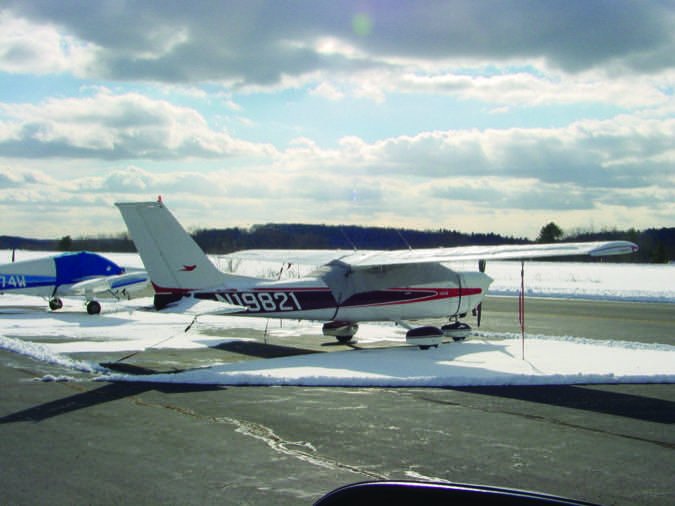
Taxiing
Even though taxiing is a common function of operating an aircraft, it poses many risks. Some of the basics you should know include the correct positioning of flight controls during windy conditions, knowing the wingspan of your aircraft and its turning radius. What is a minimum distance to safely taxi behind a jet like a Boeing 737? Where are the published “hot spots” along your taxi route? Even at your home airport, have you checked Notams recently for any runway or taxiway closures? What will be your taxi route to the active runway?
One step many pilots simply ignore is writing down taxi instructions from the tower. Especially at busy or unfamiliar airports, you may receive a taxi clearance with a lot of letters and numbers. Following along with the facility’s taxi chart or your moving map of choice always is a good idea. Having the written information available for reference can eliminate additional radio calls and help prevent a runway incursion, which could lead to an enforcement action or worse.
Propellers strikes during ground operations occur with some frequency and often mean a costly and lengthy engine teardown and inspection. Common obstacles include tiedown chains, taxiway lights, snow-covered signage or a snow pile that has turned to ice. Do not take short cuts, especially on a snow-covered ramp. Pay attention to signs and only use a marked (and plowed) taxiway or ramp area appropriate for your aircraft.
Final thoughts
Preventing aircraft ground damage should be Job One. Not only are repairs expensive, some pilots may have a tendency to underestimate the damage ground handling incidents can create. Be a good neighbor when taxiing your aircraft near other aircraft or people, and go easy on the throttle: Use just enough power to move slowly and remain under control. Always shut down the airplane when loading or unloading passengers and never taxi in or out of a hangar or building. Take the proper precautions when moving aircraft in and out of a shared hangar. Even if you don’t fly during the winter, if your aircraft is stored outside, make it a point to occasionally check on for loose tiedowns and remove excessive snow and ice. The time you spend preventing aircraft ground damage is well worth the effort.
Mike Berry is a 17,000-hour airline transport pilot, is type rated in the B727 and B757, and holds an A&P ticket with inspection authorization.




